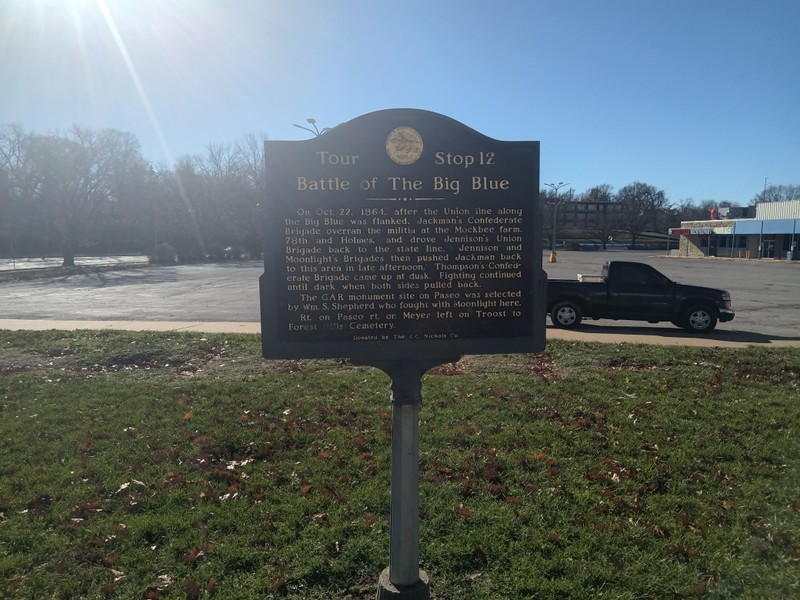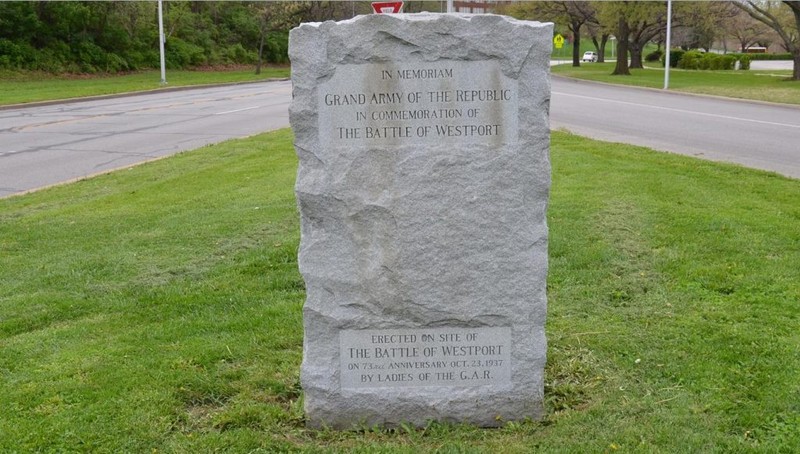Battle of Big Blue River Historical Marker Tour Stop 12 (Battle of Westport Driving Tour) (Price's Raid)
Introduction
Text-to-speech Audio
Marker Inscription: On October 22, 1864, after the Union line along the Big Blue was flanked, Jackman’s Confederate Brigade overran the Militia at the Mockbee farm, 78th and Holmes, and drove Jennison’s Union Brigade back to the state line. Jennison and Moonlight’s brigades then pushed Jackman back to this area in late afternoon. Thompson’s Confederate Brigade came up at dusk. Fighting continued until dark when both sides pulled back.
The GAR monument site on Paseo was selected by Win S. Shepard who fought with Moonlight here.
GAR Monument Inscription: In Memoriam Grand Army of the Republic Commemoration of the Battle of Westport . Erected on site of the Battle of Westport on 73rd Anniversary Oct 23, 1937. By Ladies of the G.A.R.
This historical marker marks the area where United States forces defeated Confederate troops on October 22, 1864, during the Battle of Big Blue River. The Battle of Westport, fought October 22-23, 1864, was an American Civil War battle that took place in and around the then-small settlements of Westport and Independence, Missouri. The battle was part of Price’s Raid, a Confederate offensive led by Major General Sterling Price with the goal of taking Missouri before the 1864 Presidential election. This site saw two Union brigades led by Colonels Charles R. "Doc" Jennison and Thomas Moonlight defeat Confederate brigades led by Sidney D. Jackman and Brigadier General Meriweather Jeff Thompson. The defeat of the Confederate forces at the Battle of Westport the next day was the final nail in the coffin of this last major offensive fought west of the Mississippi River and marked the beginning of a long, costly retreat of Confederates to the south.
Images
Historical Marker of The Battle of Big Blue River

Grand Army of the Republic

Backstory and Context
Text-to-speech Audio
The Civil War in Missouri, like most border states, divided the population with loyalties to the Union or Confederacy and pitted neighbor against neighbor. The conflict in Missouri was complex, with both a conventional and guerrilla war being fought by regular armies, state militias, and informal raiding parties. The early fighting of the Civil War in Missouri led to the formation of two state governments in Missouri – one supporting the Union led by Governor Hamilton Rowan Gamble in the capital of Jackson City and the pro-secession government in exile led by Governor Claiborne Fox Jackson. In 1861, Major General Sterling Price’s Missouri State Guard was pushed out of Missouri by General John C. Fremont after a notable Confederate success at the Battle of Wilson’s Creek. In 1862-1863, the conflict in Missouri was mostly marked by a guerrilla war between bushwhackers and Confederate forces against those who supported the Union and a smaller number dedicated to the abolition of slavery. This conflict was common in Missouri both before and during the Civil War, with some of the largest military engagements occurring during Price’s Raid of 1864.
Price’s Raid was an unsuccessful attempt to retake Missouri for the Confederacy between August 29 and December 3, 1864. The goal of the offensive was to revitalize the Southern cause in Missouri with a victory in the West, which Price calculated would hurt the reelection campaign of Lincoln. The plan was hatched by Confederate General Edmund Kirby Smith, commander of the trans-Mississippi Department. The primary objective was St. Louis and its arsenals, followed by Jefferson City, the capital. Price was instructed to then raid west into Kansas and Indian Territory for supplies and to hurt the Union economy in the West. The Confederates also hoped to recruit men sympathetic to the South along the way. Price formed the Army of Missouri for this offensive, numbering 12,000 men and 14 cannons, divided into three divisions. In response to the invasion, William S. Rosecrans, leader of the Department of Missouri, assembled the Army of the Border under Major General Samuel R. Cutis with roughly 35,000 men.
The first major engagement of the raid, the Battle of Pilot Knob, was a costly victory for Price. The Confederate push toward St. Louis ended at Franklin when Price decided not to even test the city's defenses. At Jefferson City, Price again decided not to launch a full-scale attack on the city and decided to instead raid westward, abandoning the idea of taking either the primary objective of St. Louis or the secondary one of the state capital. The Army of Missouri headed west into “Little Dixie,” a region in the middle of Missouri that had strong Confederate leanings, where they were further supplied and reinforced by the local populace. As October began, the Confederate forces moved west, capturing much-needed weapons at Glasgow and then pushing past a delaying action of Union forces at the Battle of Lexington and toward Independence. Significant Union forces were massing in and around Westport, including the Kansas State Militia which had been hastily called up by Governor Carney once the threat to Kansas presented by Price was fully realized. The Battle of the Big Blue River would preview the largest battle west of the Mississippi during the Civil War at the Battle of Westport.
The Battle of Big Blue River, also known as the Battle of Byram’s Ford, was the result of a Confederate attack to secure a river crossing point, across the Big Blue River which needed to be crossed to reach Westport and Kansas to the west. On October 22nd, a diversionary attack was carried out by Confederate forces against the main Union defenses blocking the Independence Road, while the main attack aimed to flank the Union forces to the south, crossing the Big Blue River at Byram’s Ford to avoid the better-defended northern stretch of the Big Blue. The main attack was carried out by Brigadier Generals Joseph Shelby and John Marmaduke’s divisions. The west bank of the river was defended by Colonel Jennison’s Brigade. After a series of failed attacks at Byram’s Ford by Brigadier General Meriweather Jeff Thompson’s Brigade, a flanking move at Hinkel’s Ford forced Jennison to retreat from his position toward Westport, halting his retreat, and the Confederate advance near where this historical marker was set around nightfall. Colonel Moonlight’s brigade arrived late in the day to reinforce Jennison. The following day, the Battle of Westport would definitively end the advance of Price’s raid. It is estimated the fighting on October 22nd resulted in around 3,000 casualties split roughly evenly between the two sides, which was a foreboding harbinger of the even bloodier battle that would follow.
The following is Colonel Charles Jennison's account of the fighting that occurred on October 22nd:
“On the morning of the 22d I was ordered with the brigade to Byram’s Crossing of the Big Blue, some eight miles from its encampment of the night previous. Arriving there we were joined by a detachment of Kansas State Militia, of Colonel command, which rendered valuable assistance in obstructing the ford of the river by felling timber, &c. About 11 a. m. the enemy’s advance made its appearance at the ford, attacking our outposts and attempting to force a crossing. The ford was so effectually obstructed, however, and in its condition wholly impassable for artillery, that for some hours little progress was made, the attacking party being repulsed each time it appeared in the front, which was defended by a strong skirmish line, securely posted, and one section of howitzer battery… At this point the First Brigade held the enemy effectually in check, notwithstanding his great superiority of numbers, until about 3 p. m., when it became evident that he had succeeded in crossing considerable bodies, both above and below, and was rapidly flanking us both on the right and left. Upon this intelligence it was determined to retire in the direction of Westport or Kansas City, toward which it was evident the efforts of the enemy were directed. Our lines at the ford having been forced back, the rebels succeeded in crossing a considerable force of dismounted cavalry, a portion of which was employed in removing obstructions in the river, while the others were deployed on either side of the road, and advanced toward us.”
The GAR Monument according to the KC Parks Service was designed by" A.J. Dehner, President, Quality Monument Co., Kansas City, Missouri." and that "The Ladies of the Grand Army of the Republic made the plans for this monument and carried the work to completion after an appeal by William S. Shepherd, the last known surviving Union veteran of the Battle of Westport. Mr. Shepherd selected the site as being where some of the heaviest fighting occurred...The memorial was erected at a cost of $350, $100 of which was contributed by Mr. Dehner who also gave of his time and talents toward the construction and completion of the monument." (KC Parks Service 2024)
Sources
“Battle of Westport Grand Army of the Republic Monument.” Kansas City Parks & Recreation, September 5, 2024. https://kcparks.org/places/battle-of-westport-grand-army-of-the-republic-monument-2/.
Byram's Ford, Big Blue River or Westport, American Battlefield Trust. Accessed December 11th, 2023. https://www.battlefields.org/learn/civil-war/battles/byrams-ford.
Collins, Charles D. Jr. (2016). Battlefield Atlas of Price's Missouri Expedition of 1864 (PDF). Fort Leavenworth, Kansas: Combat Studies Institute Press. ISBN 978-1-940804-27-9.
Lause, Mark A. (2016). The Collapse of Price's Raid: The Beginning of the End in Civil War Missouri. Columbia, Missouri: University of Missouri Press. ISBN 978-0-826-22025-7.
John Heos
“Battle of Westport Grand Army of the Republic Monument.” Kansas City Parks & Recreation, September 5, 2024. https://kcparks.org/places/battle-of-westport-grand-army-of-the-republic-monument-2/.
